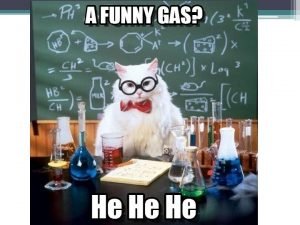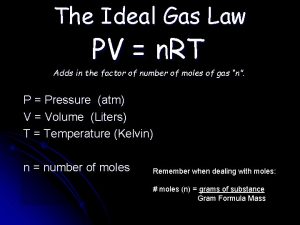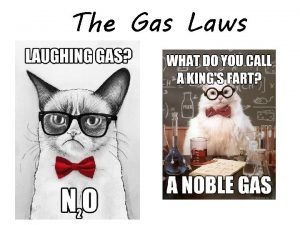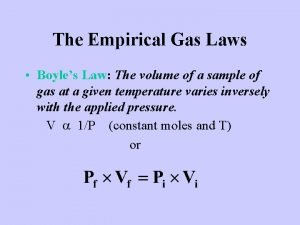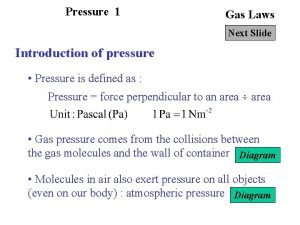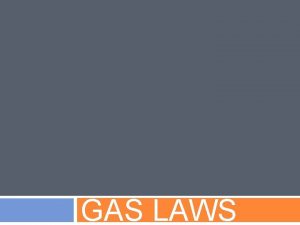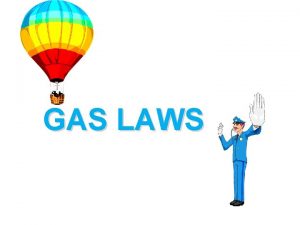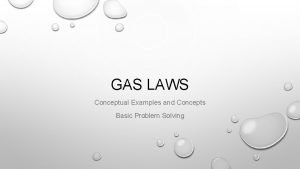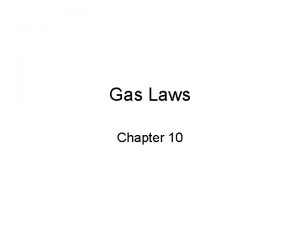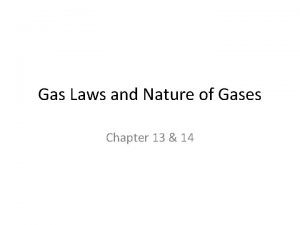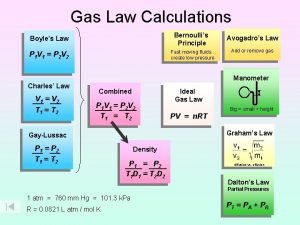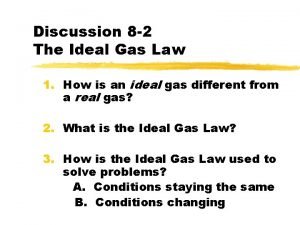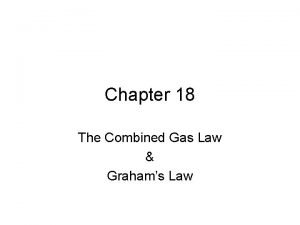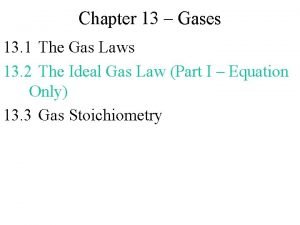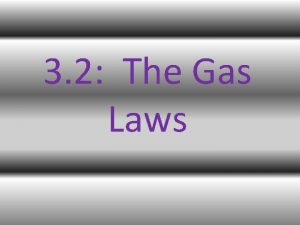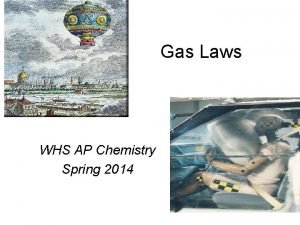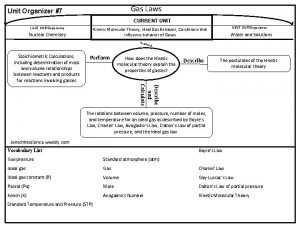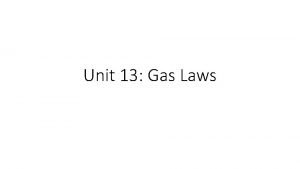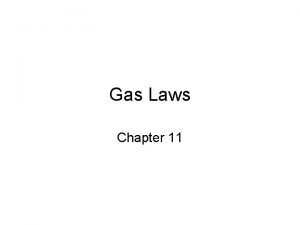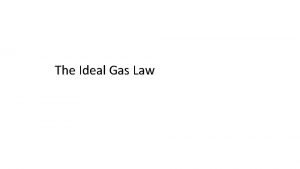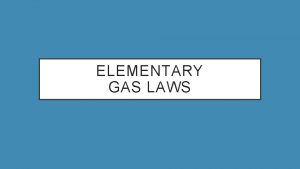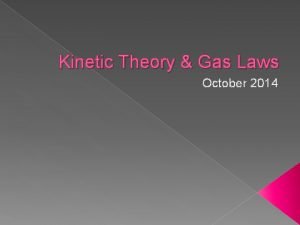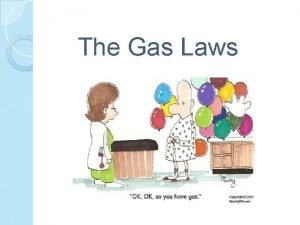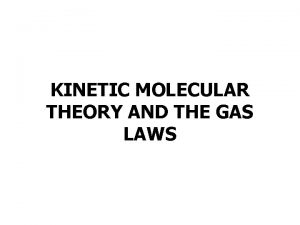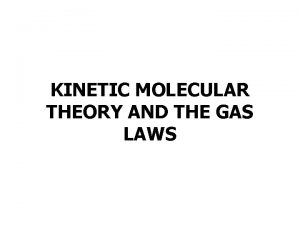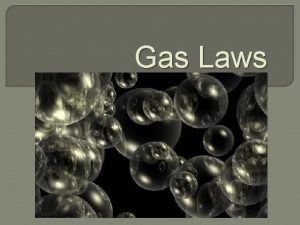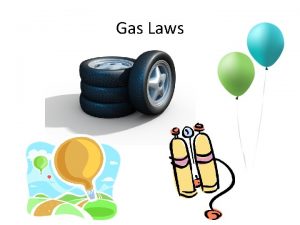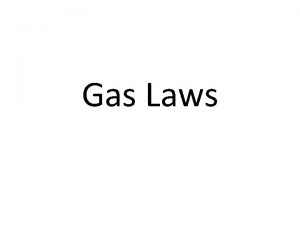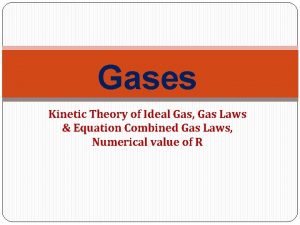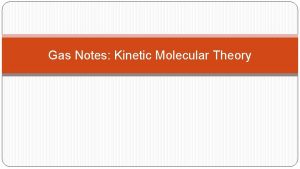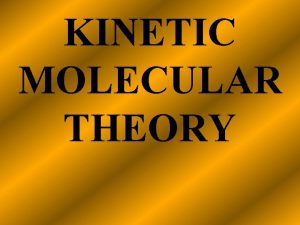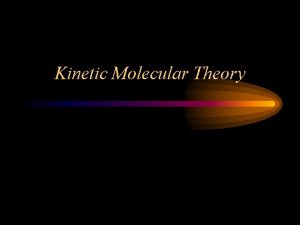The Gas Laws I Kinetic Theory kinetic theory
























- Slides: 24

The Gas Laws I. Kinetic Theory -_____ kinetic ____ theory provides a ______ model that explains the properties of ____, solids _____, liquids and ______ gases in terms of _____ particles that are motion and the ____ forces that exist always in ____ between them -actual gases don’t always obey, but ______ approximate the ______made by the _____ assumptions kinetic ____ theory A. Gas particles do not attract or repel eachother B. Gas particles are much smaller than the distances between them C. Gas particles are in constant, random motion D. No energy is lost in the collisions of gas particles E. All gases have same average kinetic energy at same temperature

The Gas Laws II. Boyle’s Law -the _______ volume of a gas _____ varies _____ inversely with the _____, pressure providing the ______ temperature is held ____ constant P 1 V 1 = P 2 V 2 or P 1 ___ P 2 V 2 ___ V 1 = If a sample of Argon gas occupies a volume of 10. 0 liters at a pressure of 200 kilopascals, at what pressure would the sample of gas occupy 5. 0 liters, if the temperature remains constant? Robert Boyle (1627 -1691) P 1 ___ P 2 = 200 k. Pa ______ P 2 V 2 ___ V 1 5. 0 L ____ = 10. 0 L = 400 k. Pa

The Gas Laws II. Boyle’s Law If a sample of Carbon dioxide gas occupies a volume of 35. 0 liters at a pressure of 1. 10 atmospheres, what volume would the sample of gas occupy at 1. 25 atmospheres, if the temperature remains constant? Boyle’s Vacuum Chamber, Designed by Robert Hooke P 1 ___ P 2 V 2 ___ V 1 = 1. 10 atm V 2 _______ = 1. 25 atm 35. 0 L V 2 = 30. 8 L

The Gas Laws III. Charles’s Law -the _______ volume of a gas _____ varies _____ directly with the ______, temperature providing the _____ pressure is held ____ constant V 1 T 2 = V 2 T 1 or V 1 ___ V 2 = T 1 ___ T 2 If a sample of Chlorine gas occupies a volume of 250 milliliters at a temperature of 22°C, what volume would the sample of gas occupy at -22°C, if the pressure remains constant? We need a temperature Jacques Charles (1746 -1823) V 1 ___ = V 2 250 m. L ______ V 2 T 1 ___ T 2 22°C ____ = -22°C scale with no zero, and no negative values! K = °C + 273 250 m. L 295 K ______ = V 2 251 K V 2 = -250 m. L? A negative volume? = 213 m. L

The Gas Laws III. Charles’s Law 1. Hypothesis: What is the relationship between volume and temperature of a gas? 2. Prediction: 3. Gather Data: A. Safety: 1. Be careful not to drip or splash hot vegetable oil on yourself. Goggles mandatory, aprons recommended. 2. Capillary tubes break easily. Be cautious of broken, jagged ends.

The Gas Laws III. Charles’s Law 3. Gather Data: B. Procedure: 1. Assemble thermometer/capillary tube apparatus by carefully wrapping rubber bands around both to hold the capillary tube to thermometer, arranging the open end toward the bulb of thermometer, just short of the end.

The Gas Laws III. Charles’s Law 3. Gather Data: B. Procedure: 1. Assemble thermometer/capillary tube apparatus by carefully wrapping rubber bands around both to hold the capillary tube to thermometer, arranging the open end toward the bulb of thermometer, just short of the end.

The Gas Laws III. Charles’s Law 3. Gather Data: B. Procedure: 2. Immerse the capillary tube on thermometer completely under the surface of the hot oil bath. Allow the temperature on your thermometer to reach 140°C. Then, lift thermometer from the oil bath, pausing for 5 seconds to allow oil to rise up into the tube. 3. Carry the tube/thermometer assembly back to your lab table, being careful to catch the drips of hot oil on a paper towel. Lay thermometer on a sheet of paper towel. Mark the position of the oil plug. Take note of the temperature. As the air in the tube cools, mark the position of the oil plug as it moves along the tube on the

The Gas Laws III. Charles’s Law 3. Gather Data: B. Procedure: 3. paper towel. With each mark on the paper towel recording the position of the oil plug, record the temperature at the time the mark was made. Take as many position/temperature readings as possible, until thermometer reads room temperature (about 23°C).

The Gas Laws III. Charles’s Law 3. Gather Data: B. Procedure: 3. paper towel. With each mark on the paper towel recording the position of the oil plug, record the temperature at the time the mark was made. Take as many position/temperature readings as possible, until thermometer reads room temperature (about 23°C). 4. Plot data on Excel spreadsheet and graph results.

The Gas Laws III. Charles’s Law 4. Analyze Data: Temperature (in °C) Length (in mm)

The Gas Laws III. Charles’s Law 4. Analyze Data: 5. Draw Conclusions: Temperature (in °C) Length (in mm)

The Gas Laws III. Charles’s Law -_____ absolute _____ zero is the _______ lowest possible theoretical temperature, equal to _____, -273. 15°C and is the ______ temperature at which the ____ volume of a sample of gas is _____, zero and all ____, random Brownian movement of particles ____ ceases _____ William Thomson (Lord Kelvin) (1824 -1907) -the coldest _______ actual temperature is _______, 4. 22 K or _____, the temperature of ______ -268. 78°C liquid _______ Helium

The Gas Laws III. Charles’s Law If a sample of methane gas occupies a volume of 14. 75 liters at a temperature of 68°F, at what temperature, in °F, would the sample of gas occupy 16. 00 liters, if the pressure remains constant? Charles’s Hydrogen-filled balloon over Paris, 1783 V 1 ___ = V 2 14. 75 L ______ 16. 00 L T 2 T 1 ___ T 2 293 K _____ = T 2 = = 318 K 113°F °F = 9/5 °C + 32 K = °C + 273

The Gas Laws IV. Gay-Lussac’s Law -the _______ pressure of a gas _____ varies _____ directly with the ______, temperature providing the volume is held _________ constant P 1 T 2 = P 2 T 1 or P 1 ___ P 2 = T 1 ___ T 2 If the pressure in a propane tank is 965 mm Hg at a temperature of 25°C, what would the pressure in the tank be at 50°C, if the volume remains constant? Joseph Gay-Lussac (1778 -1850) P 1 ___ P 2 T 1 ___ T 2 = K = °C + 273 965 mm Hg _____ = P 2 = 298 K _____ 323 K 1040 mm Hg

The Gas Laws IV. Gay-Lussac’s Law If the air pressure in an autoclave is 833 torr at a temperature of 212°F, at what temperature, in °F, would the air pressure be 900 torr, if the volume remains constant? Gay-Lussac and Jean-Baptiste Biot in Hydrogen balloon, 1804 P 1 ___ = P 2 833 torr ______ 900 torr T 2 T 1 ___ T 2 373 K _____ = T 2 = = 403 K 266°F °F = 9/5 °C + 32 K = °C + 273

The Gas Laws V. Combined Gas Law -the _______ pressure of a gas is _____ inversely proportional to ____ volume and directly P 1 V 1 P 2 V 2 proportional to ______, temperature and _____ = T 1 T 2 ____ volume is _____ directly proportional to temperature ______ If the volume of a sample of Hydrogen sulfide gas is 2. 00 liters at a pressure of 110 kilopascals and a temperature of 30. 0°C, what is the volume of the sample of Hydrogen sulfide, in liters, at a temperature of 80. 0°C and a pressure of 440 kilopascals? P 1 V 1 P 2 V 2 _____ = T 1 T 2 K = °C + 273 (110 k. Pa) (2. 00 L) _______ 303. 0 K V 2 = = (440 k. Pa) V 2 _____ 353. 0 K 0. 582 L

The Gas Laws V. Combined Gas Law If a Helium-filled balloon at sea level has a volume of 2. 1 liters at a pressure of 0. 998 atmospheres and a temperature of 36°C, and it is released and rises to an elevation at which the temperature is 28°C and the pressure is 0. 900 atmospheres, what will be the new volume of the balloon? P 1 V 1 P 2 V 2 _____ = _____ T 1 T 2 K = °C + 273 (0. 998 atm)(2. 1 L) _______ 309 K V 2 = = 2. 3 L (0. 900 atm)V 2 _____ 301 K

The Gas Laws VI. Avogadro’s Principle -______ equal ____ volumes of gases at the same ______ temperature and _____ pressure contain Amadeo Avogadro (1776 -1856) ______ equal numbers of ____ particles -one ______ mole of gas contains _____ 6. 02 x 1023 particles and occupies _______ 22. 4 L at standard temperature and pressure, _____ 0. 00°C and ____ 1. 00 atm which is ______ How many molecules in 3. 73 liters of ozone at STP? 3. 73 L O 3 x 1 mole O 3 ______ 22. 4 L O 3 x 6. 02 x 1023 molecules O 3 _________ 1 mole O 3 conversion factor = 1. 00 x 1023 molecules O 3

The Gas Laws VI. Avogadro’s Principle What is the volume, in liters, of 0. 881 moles of Fluorine gas at STP? 0. 881 mole F 2 x 22. 4 L F 2 ____ 1 mole F 2 = 19. 7 L F 2 How many moles of Nitrogen gas are in 2. 00 liters at STP? 2. 00 L N 2 x 1 mole N 2 ____ 22. 4 L N 2 = 0. 0893 moles N 2 What is the volume, in liters, of 5. 0 kilograms of methane at STP? 5. 0 kg CH 4 x 1000 grams CH 4 ______ 1 kg CH 4 x 1 mole CH 4 _______ 16. 043 grams CH 4 x 22. 4 L CH 4 _____ 1 mole CH 4 = 7. 0 x 103 L CH 4 conversion factor What mass, in grams, of Nitrogen dioxide occupies 15. 50 liters at STP? 15. 50 L NO 2 x 1 mole NO 2 _____ 22. 4 L NO 2 x 46. 005 grams NO 2 _______ 1 mole NO 2 = 31. 8 g NO 2

The Gas Laws VII. Ideal Gas Law -______ Avogadro’s Law, ____ Boyle’s Law, Charles’s ____ Law, and _______ Gay-Lussac’s Law can be combined into one mathematical statement called the _______, Ideal Gas Law which describes pressure ____, volume the relationship among _____, ______, temperature and the number of ______ moles of a gas ideal gases, as opposed to ______ real gases, is -______ particles take up no one in which the gas ______ space and have no ________ intermolecular forces between them, and so obey all of the gas laws under all conditions -______ real gases obey the gas laws, except at extreme conditions, like very _______ high pressure and very ____ low ______, temperature or when the gas is very ______, polar like water, or when _____ particles large like butane are very ______,

The Gas Laws VII. Ideal Gas Law PV = n. RT; R = ideal gas constant = 0. 0821 L·atm mol·K How many moles of Hydrogen gas are contained in a vessel with a volume of 3. 0 liters at a temperature of 300 K and a pressure of 1. 50 atmospheres? PV = n. RT R = 0. 0821 L·atm mol·K (1. 50 atm)(3. 0 L) = n (0. 0821 L·atm) (300 K) mol·K n = 0. 18 moles At what Celsius temperature would 2. 49 moles of Helium gas occupy 1. 00 liters if the pressure was 143 k. Pa? PV = n. RT R = 8. 314 L·k. Pa mol·K (143 k. Pa) (1. 00 L) = 2. 49 moles(8. 314 L·k. Pa) T mol·K T = 6. 91 K = -266. 09 °C

The Gas Laws VII. Ideal Gas Law D = MP; M = molar mass of the gas RT What is the density of Carbon dioxide at standard temperature and pressure? D = MP RT D D = = (44. 009 g/mole)(1. 00 atm) __________ (0. 0821 L·atm)(273. 00 K) mol·K 1. 96 g·atm·mol·K = 1. 96 g/L mol·L·atm·K What is the molar mass of a gas that has a density of 1. 09 g/L at a pressure of 1. 02 atm and a temperature of 25°C? Which gas is it? D M (1. 02 atm) 1. 09 g/L = __________ (0. 0821 L·atm)(298 K) mol·K = MP RT M = = 26. 1 g/mol; C 2 H 2 ethyne (acetylene) 26. 1 g·L·atm·K L·mol·K·atm

The Gas Laws VIII. Gas Stoichiometry What volume, in liters, of oxygen is required for the complete combustion of 4. 00 liters of propane gas, if the pressure and temperature remain constant? 1 C 3 H 8 + 5 O 2 4. 00 liters C 3 H 8 3 CO 2 x 5 liters O 2 _____ 1 liter C 3 H 8 + 4 H 2 O = 20. 0 L O 2 Avogadro’s Law says that a mole of any gas under the same conditions of temperature and pressure occupy the same volume, so the mole ratio is a volume ratio, too. What mass, in grams, of Ammonium nitrate is required to produce 0. 100 liters of Dinitrogen monoxide at STP? 1 NH 4 NO 3 0. 100 liters N 2 O x 1 N 2 O + 2 H 2 O 1_____ mole N 2 O x 22. 4 liters N 2 O 1 mole NH 4 NO 3 _____ 1 mole N 2 O x 80. 043 g NH 4 NO 3 ______ 1 mole NH 4 NO 3 = 0. 357 g NH 4 NO 3
 Postulates of kinetic molecular theory
Postulates of kinetic molecular theory Useless laws weaken the necessary laws
Useless laws weaken the necessary laws Gas laws crash course
Gas laws crash course Relationship between pressure and volume direct or indirect
Relationship between pressure and volume direct or indirect Gas laws
Gas laws Gas law formula
Gas law formula All the gas laws
All the gas laws Different gas laws
Different gas laws Implosion
Implosion Gas laws conceptual questions
Gas laws conceptual questions Boyles law problem solving
Boyles law problem solving Chapter 13 gas laws worksheet answer key
Chapter 13 gas laws worksheet answer key 3 gas laws
3 gas laws Different gas laws
Different gas laws Combined gas laws
Combined gas laws 13-4 practice problems chemistry
13-4 practice problems chemistry Which gas laws are inversely proportional
Which gas laws are inversely proportional Empirical gas laws
Empirical gas laws Ap chemistry gas laws
Ap chemistry gas laws Gas law graphic organizer
Gas law graphic organizer Gas laws hot air balloon
Gas laws hot air balloon Boyle's law formula example
Boyle's law formula example Kmt gas laws
Kmt gas laws Gas laws formula
Gas laws formula Empirical gas laws
Empirical gas laws
